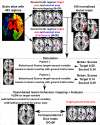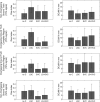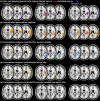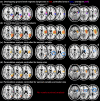Post-stroke cognitive deficits rarely come alone: Handling co-morbidity in lesion-behaviour mapping
- PMID: 31782852
- PMCID: PMC7267998
- DOI: 10.1002/hbm.24885
Post-stroke cognitive deficits rarely come alone: Handling co-morbidity in lesion-behaviour mapping
Abstract
Post-stroke behavioural symptoms often correlate and systematically co-occur with each other, either because they share cognitive processes, or because their neural correlates are often damaged together. Thus, neuropsychological symptoms often share variance. Many previous lesion-behaviour mapping studies aimed to methodologically consider this shared variance between neuropsychological variables. A first group of studies controlled the behavioural target variable for the variance explained by one or multiple other variables to obtain a more precise mapping of the target variable. A second group of studies focused on the shared variance of multiple variables itself with the aim to map neural correlates of cognitive processes that are shared between the original variables. In the present study, we tested the validity of these methods by using real lesion data and both real and simulated data sets. We show that the variance that is shared between post-stroke behavioural variables is ambiguous, and that mapping procedures that consider this variance are prone to biases and artefacts. We discuss under which conditions such procedures could still be used and what alternative approaches exist.
Keywords: VLSM; lesion-deficit inference; nuisance regression; principal component analysis; statistical parametric mapping.
© 2019 The Authors. Human Brain Mapping published by Wiley Periodicals, Inc.
Conflict of interest statement
There are no conflict of interest to report.
Figures







Similar articles
-
Post-stroke outcomes predicted from multivariate lesion-behaviour and lesion network mapping.Brain. 2022 May 24;145(4):1338-1353. doi: 10.1093/brain/awac010. Brain. 2022. PMID: 35025994 Free PMC article.
-
Lesion symptom mapping of domain-specific cognitive impairments using routine imaging in stroke.Neuropsychologia. 2022 Mar 12;167:108159. doi: 10.1016/j.neuropsychologia.2022.108159. Epub 2022 Jan 15. Neuropsychologia. 2022. PMID: 35041840
-
Strategic infarct location for post-stroke cognitive impairment: A multivariate lesion-symptom mapping study.J Cereb Blood Flow Metab. 2018 Aug;38(8):1299-1311. doi: 10.1177/0271678X17728162. Epub 2017 Sep 12. J Cereb Blood Flow Metab. 2018. PMID: 28895445 Free PMC article.
-
On the validity of lesion-behaviour mapping methods.Neuropsychologia. 2018 Jul 1;115:17-24. doi: 10.1016/j.neuropsychologia.2017.07.035. Epub 2017 Aug 3. Neuropsychologia. 2018. PMID: 28782546 Review.
-
Adapting the concepts of brain and cognitive reserve to post-stroke cognitive deficits: Implications for understanding neglect.Cortex. 2017 Dec;97:327-338. doi: 10.1016/j.cortex.2016.12.006. Epub 2016 Dec 16. Cortex. 2017. PMID: 28049565 Review.
Cited by
-
Mapping the human praxis network: an investigation of white matter disconnection in limb apraxia of gesture production.Brain Commun. 2022 Jan 13;4(1):fcac004. doi: 10.1093/braincomms/fcac004. eCollection 2022. Brain Commun. 2022. PMID: 35169709 Free PMC article.
-
The relationship between motor pathway damage and flexion-extension patterns of muscle co-excitation during walking.Front Neurol. 2022 Oct 28;13:968385. doi: 10.3389/fneur.2022.968385. eCollection 2022. Front Neurol. 2022. PMID: 36388195 Free PMC article.
-
Disentangling poststroke cognitive deficits and their neuroanatomical correlates through combined multivariable and multioutcome lesion-symptom mapping.Hum Brain Mapp. 2023 Apr 15;44(6):2266-2278. doi: 10.1002/hbm.26208. Epub 2023 Jan 20. Hum Brain Mapp. 2023. PMID: 36661231 Free PMC article.
-
Interpreting and validating complexity and causality in lesion-symptom prognoses.Brain Commun. 2023 Jun 5;5(3):fcad178. doi: 10.1093/braincomms/fcad178. eCollection 2023. Brain Commun. 2023. PMID: 37346231 Free PMC article. Review.
-
Mapping sentence comprehension and syntactic complexity: evidence from 131 stroke survivors.Brain Commun. 2024 Nov 15;6(6):fcae379. doi: 10.1093/braincomms/fcae379. eCollection 2024. Brain Commun. 2024. PMID: 39554380 Free PMC article.
References
Publication types
MeSH terms
LinkOut - more resources
Full Text Sources
Medical

